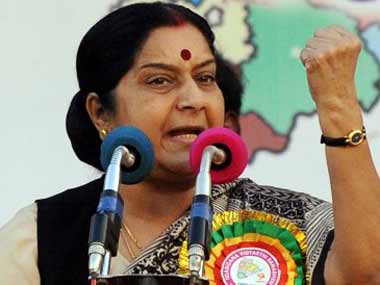External Affairs Minister Sushma Swaraj announced on Friday after meeting her Chinese counterpart Wang Yi in New York that India and China had agreed to resolve their border stand-off in Chumar in Jammu and Kashmir’s Ladakh region and described it as a “big accomplishment”. Well, the proof of the pudding is in eating it as you can never be sure about the real motives of the Chinese. [caption id=“attachment_1732947” align=“alignleft” width=“380”]  External Affairs Minister Sushma Swaraj. AFP[/caption] Past trends and current geopolitical trends show that Swaraj may have to eat crow on this. Here is why. After meeting Wang, Swaraj said that “timelines” had been decided about the Chinese troops’ withdrawal from Chumar (where they had entered shortly before Chinese President Xi Jinping arrived on a state visit to India on 17 September) and added that the withdrawal of the Chinese troops would begin on Friday and completed by 30 September. “I am happy to tell you that both nations have sat down and resolved the issue. Timelines have been decided,” she said. This raises several questions. The Chinese troops made a deliberate incursion into the Indian territory within a matter of few hours. Why should it take them five days to completely withdraw from the Indian territory? Does it not endow China with a privilege of repeating more incursions within a few hours and vacating these incursions in a few days in future? Doesn’t it, in a way, authorise Chinese troops to be on Indian soil for days together if they choose to carpet bomb India with such incursions? Have India and China reached an understanding about the Chinese incursions which have become as repetitive as common cold? Also, where is the guarantee that China will not repeat the same act in the same area or elsewhere in near future? One may argue that that the Indian troops need some time to go back to their 1 September, 2014 position, which Swaraj talked about, as the infrastructure on the Indian side is not as good as it is on the Chinese side. This implicitly means that while the Chinese troops can be swiftly back to their 1 September location, the Indians will need several days more for doing that in view of infrastructural difficulties. This is the crux of the problem. The Chinese have a vibrant and virtually all-weather infrastructural network on their side of the Line of Actual Control (LAC), but India lacks the same. The entire problem in Chumar at the bottom of the current India-China crisis started when India started to build a patch of road in the area. The Chinese objected to this construction as Chumar is one area where the Indians are better poised strategically than the Chinese and the Chinese are well aware of that. So, while the Chinese have themselves constructed roads right up to Chumar, like they have in virtually all areas along the LAC, they are now stalling India’s catch-up moves. This obviously means that the past governments had been virtually sleeping for years, if not decades, while the Chinese juggernaut was in full flow and busily constructing road networks in their territories and knocking at the doors of India along the LAC. Now that the Chinese have well-laid roads and other military infrastructure links to the last mile along the LAC, they are not allowing India the same after New Delhi awoke to this harsh reality some years ago. This is the crux of the whole problem between India and China and explains why these specific areas of Ladakh are the favoured destinations of Chinese incursions in the recent past. The Narendra Modi government will be mistaken if it were to believe that Chinese incursions would stop after Sushma Swaraj’s talks with Wang Yi in New York. No broad understanding was reached between the two foreign ministers. They merely looked at a one-off malaise and the remedy agreed to also was one-off. No institutionalized mechanism has been arrived at by the two foreign ministers for warding off such problems in future. In many ways, the Chinese incursion in Chumar was nearing its expiry date and was ripe for a natural death, while the Indian government is trying to project the problem’s resolution as a “big accomplishment”. After all, if any institutionalized mechanisms were to be found, these should have come about when China’s top most leader, President Xi Jinping, was on Indian soil. Therefore, the Modi government would only be fooling the people by claiming resolution of the Chumar stand-off. Whatever materialized through past several days of behind-the-scenes hectic diplomacy and announced by Sushma Swaraj in New York after meeting her Chinese counterpart was just a formality. Actually, a new disturbing trend is visible of late. Incursions have become an unannounced tenet of China’s India policy just as Infiltration has been for Pakistan for decades. Future events will have to be watched closely to determine whether there is any truth in this supposed trend which may be described as I-2 pincer diplomacy of China and Pakistan with respect to India – the ‘I’ meaning Incursions for China and Infiltration for Pakistan. - The writer is Firstpost Consulting Editor and a strategic analyst who tweets @Kishkindha.
The Narendra Modi government will be mistaken if it were to believe that Chinese incursions would stop after Sushma Swaraj’s talks with Wang Yi in New York.
Advertisement
End of Article
Written by Rajeev Sharma
Consulting Editor, First Post. Strategic analyst. Political commentator. Twitter handle @Kishkindha. see more


)

)
)
)
)
)
)
)
)



